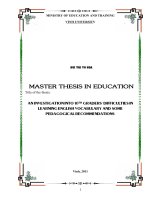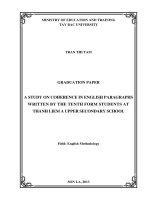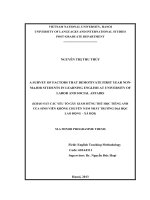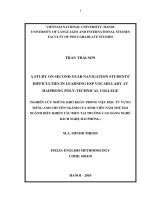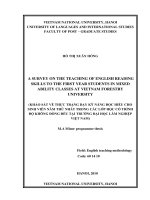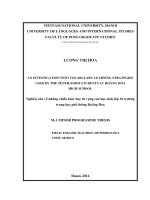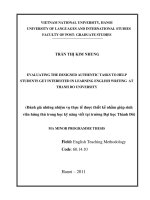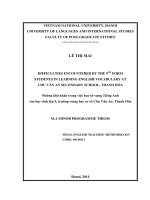Difficulties encourtered by the 9th form students in learning English vocabulary at Chu Văn An secondary school
Bạn đang xem bản rút gọn của tài liệu. Xem và tải ngay bản đầy đủ của tài liệu tại đây (1.65 MB, 24 trang )
MINOR THESIS
Difficulties encourtered by the 9 th form
students in learning English vocabulary at Chu
Văn An secondary school
By: Lê Thị Mai
Field: English Language Teaching Methodology
Course: K21
Supervisor: Dương Thị Nụ, Ph
Design
Part 1
Part 3
Introduction
Part 2
Conclusion
Development
Chapter 1
Literature review
Chapter 2
Methodology
Chapter 3
Data analysis and
discussion
Chapter 4
Findings and
solutions
PART A: INTRODUCTION
RATIONALE
- Vocabulary plays a very important role in learning and
teaching English.
- Vocabulary, however, is really a big challenge to every
student, especially students at Chu Văn An secondary
school.
AIMS OF THE STUDY
- Finding out the factors that cause difficulties for the
9th form students in learning English vocabulary at
Chu Văn An secondary school.
- Giving some suggestions to reduce students’
difficulties to help them study vocabulary more
effectively.
RESEARCH QUESTIONS
1. What are the factors causing difficulties for the 9 th
form students’ learning of English vocabulary at Chu
Văn An secondary school?
2. What solutions should be suggested to help the
students learn English vocabulary better?
SCOPE OF THE STUDY
- The study was carried out with the 9 th form
students at Chu Văn An secondary school, Thanh
Hóa.
- The findings and suggested solutions are also
provide to improve the students’ English
vocabulary learning at Chu Văn An secondary
school.
PART B: DEVELOPMENT
CHAPTER 1: LITERATURE REVIEW
- An overview of vocabulary
- Vocabulary learning
- Factors affecting vocabulary learning
- Previous work review
CHAPTER 2: METHODOLOGY
- Methods of the study: Qualitative and
quantitative.
- Data collection instruments: Survey
questionnaire, informal interview and classroomobservation.
- Subjects of the study: The 9th form students at
Chu Văn An secondary school.
CHAPTER 3: DATA ANALYSIS DISCUSSION
Students’ level of English vocabulary
Students’ attitudes towards learning new words
Students’ difficulties in learning new words
Options
Number of Percentage
students
Every day
6
4,6%
Three times a week
9
6,9%
Twice a week
13
10%
Once a week
9
6,9%
When you feel like to learn
93
71,5%
Students’ time for learning new words
Options
Number of Percentage
students
Writing words in English many times
94
72,3%
Reading words many times
11
8,5%
Learning words through textual context
4
3,1%
Learning words through listening
5
3,8%
Learning words through word formation
8
6,2%
Learning words through communication
0
0%
Making a word list
3
2,3%
Other ways
5
3,8%
Ways of learning new words
Teachers’ ways to present new words
CHAPTER 4: FINDINGS AND SOLUTIONS
FINDINGS
Other factors
Internal factors
External factors
INTERNAL FACTORS
- Lack of motivation
- Ineffective ways of learning vocabulary
- Age of the learners
EXTERNAL FACTORS
- The English learning environment
- Vocabulary learning task
- Lack of time
OTHER FACTORS
- Lack of teaching aids and reference
materials
- Intralexical factors
SUGGESTED SOLUTIONS
- Encouraging students’ self- study
- Providing students with different vocabulary
learning strategies
- Improving various techniques in teaching
vocabulary
Encouraging students’ self- study
- Helping students realize that success in learning
depends much on their own efforts.
- Helping students understand the nature of
vocabulary learning process
- Playing an important role as a source of help to
give them homework and feedback.
Providing students with
different vocabulary learning strategies
- Learning vocabulary through communication
- Learning vocabulary through listening
- Learning vocabulary by guessing from context
- Learning vocabulary through word formation
- Learning vocabulary by using bilingual dictionary
Improving various
techniques in teaching vocabulary
- Basing on characteristic of different groups of students to
use and change appropriate teaching techniques.
- Using effectively visual aids, gestures, facial expressions…,
especially word games to motivate students’ English learning.
- Creating more exercises with different forms and levels of
difficulty.
PART C: CONCLUSION
- Recapitulation of the study
- Conclusions
- Limitations of the study
- Suggestions for further research

